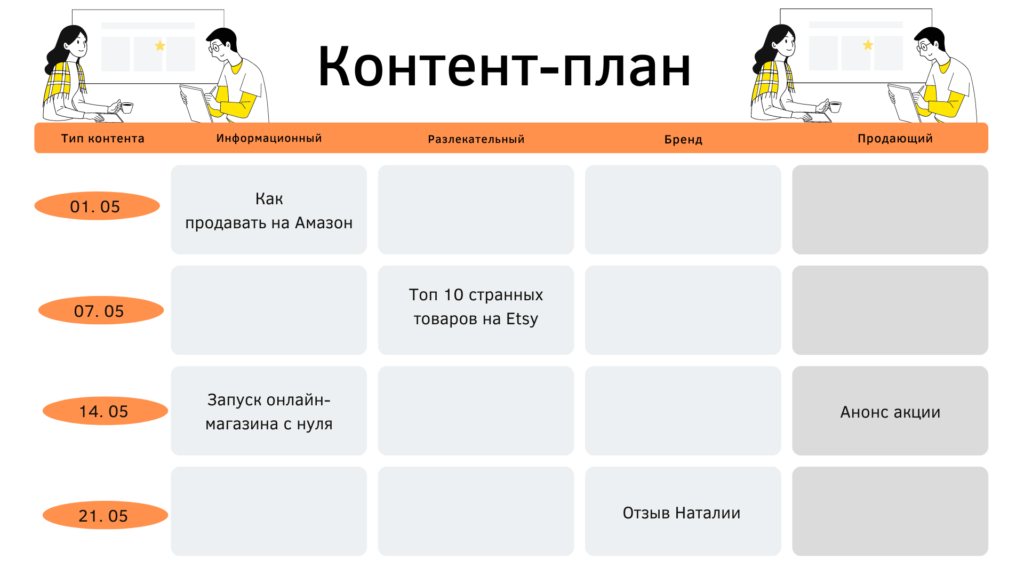We will tell you why an online store needs a content plan and how to use texts to increase sales, brand awareness, and organic promotion on Google.
A content plan is a strategic calendar that answers the following questions: WHEN, AT WHAT TIME, WHAT, WHERE, and WHY you will publish content
Most often, the need to create such a calendar is associated with the promotion of a page on social media (Instagram, Facebook, TikTok, YouTube).

However, it is necessary not only for bloggers but for all online entrepreneurs without exception. In this article, we share universal tips on how to write it correctly and where to get ideas for publications.
Firstly, for high-quality blogging on the website. Regular articles will help not only to attract new visitors (for this purpose, it is worth filling the texts with keywords), but also to increase the position in the search results (Google likes it when a website is systematically worked on).
Secondly, for email marketing, i.e. mailings to the customer base, which will help build long-term trusting relationships with the audience and increase sales.
Thirdly, for external publications, i.e. for placing expert content on third-party platforms and websites, which helps to implement an SEO strategy and increases brand awareness.
And, of course, any online store cannot do without a social media profile, which also needs to be filled with some information.
From a technical point of view, we can divide content into graphic content (photos, illustrations, screenshots, etc.), video, audio, and texts. However, we are more interested in its “meaningful” content, i.e. the tasks that the publication solves
This is always beneficial for the reader. For example: a person who wants to buy a bicycle will definitely look for information on how to choose one, which models are best for specific purposes, what experts say about a particular brand.

So, with the help of informational content, we help the user to understand our product and get answers to their questions. For this purpose, we most often use formats such as:
Targeted at:
a) the part of the audience that is ready to buy something, but still has doubts for some reason;
b) building a reputation among new users.
The following formats are suitable for these tasks:
Even the strictest CEO of an international holding company sometimes gets tired of his seriousness and wants to see a cute cat (c)
Many people think that there is no room for memes, comics or provocations in their niche. However, readers get tired very quickly not only of advertising, but also of a lot of valuable and useful information. Therefore, from time to time, any blog/channel or page should be diluted with something fun.
It can be:
In addition to the main goal (to entertain), this type of content has many hidden motives. For example, engaging users in discussion or ensuring virality (when people share links to your post with their friends).
Everything here is as simple and transparent as possible: the purpose of such texts/videos is to sell directly to a hot audience. Through:
It is believed that when you create a content plan for a blog, 40% should be given to entertainment content, 30% to brand, 5% to sales, and 25% to educational. Some even call it the “golden rule”. However, such a distribution is more appropriate for a personal blog than for creating an image of an expert or a website of a serious company. How to find the optimal ratio?
The first thing to do is to set a specific and achievable goal.
Why do you need a blog on your website? Attract x2 leads from search in the current month
What result is expected from the email campaign? Orders for a total amount of at least $1000 during the campaign period
What results should the Instagram page give? Increase brand awareness by attracting 5 thousand new followers in 3 months
Based on the goal, you can form a primary hypothesis about what type of content should prevail.
As a second step, we traditionally study our competitors.
What are their most popular posts?
Where are the most comments and views?
What formats do they use?
The third step is to study your target audience. Analyse what questions your support team is asked, what comments customers leave in product cards.
Life hack. The answerthepublic website will help you understand the needs of your target audience and get 100 content topics in less than a minute. Just enter the name of your niche, select the country and language.
Based on this simple analysis, a strategy is created: WHAT we will do and WHY we will do it. The next step is to write out a step-by-step implementation, i.e. the same content plan. You can divide all the information into certain headings or focus solely on the type/task of your publications.
We hope this article answered your question about how to create a content plan and was as useful as possible. And we remind you that you can entrust this and other tasks to our Digital team.